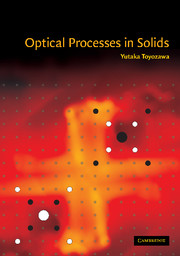Book contents
- Frontmatter
- Contents
- Preface
- Acknowledgments
- List of principal symbols
- 1 Radiation field
- 2 Quantum mechanics
- 3 Interaction of radiation with matter
- 4 Electronic vs. nuclear motions and the optical spectra of localized electrons in solids
- 5 Lattice vibrations
- 6 Electric susceptibility and dielectric constant
- 7 One-electron states in solids
- 8 Excitons
- 9 Polaron and the self-trapped state
- 10 Optical spectra of exciton in the phonon field Overview
- 11 Higher-order optical processes
- 12 Inner-shell excitation
- 13 Photo-induced structural changes
- 14 Light, matter and life (A scenario for the origin of life and its evolution)
- Appendix 1 Derivation of exciton Hamiltonian from many-body Hamiltonian
- Appendix 2 Transient spectra for second-order optical processes
- References (by chapter)
- Subject index
12 - Inner-shell excitation
Published online by Cambridge University Press: 10 December 2009
- Frontmatter
- Contents
- Preface
- Acknowledgments
- List of principal symbols
- 1 Radiation field
- 2 Quantum mechanics
- 3 Interaction of radiation with matter
- 4 Electronic vs. nuclear motions and the optical spectra of localized electrons in solids
- 5 Lattice vibrations
- 6 Electric susceptibility and dielectric constant
- 7 One-electron states in solids
- 8 Excitons
- 9 Polaron and the self-trapped state
- 10 Optical spectra of exciton in the phonon field Overview
- 11 Higher-order optical processes
- 12 Inner-shell excitation
- 13 Photo-induced structural changes
- 14 Light, matter and life (A scenario for the origin of life and its evolution)
- Appendix 1 Derivation of exciton Hamiltonian from many-body Hamiltonian
- Appendix 2 Transient spectra for second-order optical processes
- References (by chapter)
- Subject index
Summary
Inner-shell electrons and synchrotron radiation
We have so far been concerned with the electrons in the outermost shell of atoms which play the main roles in the formation of interatomic bonds resulting in the aggregation of atoms into molecules or condensed matter. Material properties sensitive to external perturbations are governed by these electrons.
In contrast to these valence electrons (in insulators) and conduction electrons (in metals and semiconductors), the inner-shell electrons (also called core electrons) with which we shall be concerned in this chapter are more tightly bound around each nucleus and can be assumed to a good approximation to be localized within a particular atom. They are much less influenced by other atoms except through the chemical shift due to surrounding atoms or ions which is more or less common to all inner shells of the same atom (such as the Madelung potential). The inner-shell electrons have been left out of the main stream of molecular and condensed matter spectroscopy, simply because of the rather limited light sources in the regions of energy (vacuum ultraviolet (VUV) to X-ray) needed for the excitation of such deep-lying electrons.
The situation changed completely when synchrotron radiation (SR) became accessible to spectroscopic and structural researchers. It is a sort of Bremsstrahlung, the electromagnetic radiation emitted by electrons with high velocities in the relativistic regime which are constantly subjected to transverse acceleration (due to the Lorentz force generated by the bending magnets) on their circular orbit in the synchrotron.
- Type
- Chapter
- Information
- Optical Processes in Solids , pp. 284 - 318Publisher: Cambridge University PressPrint publication year: 2003

